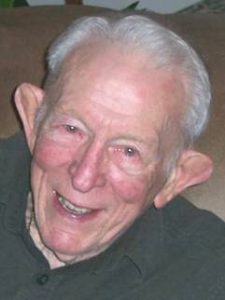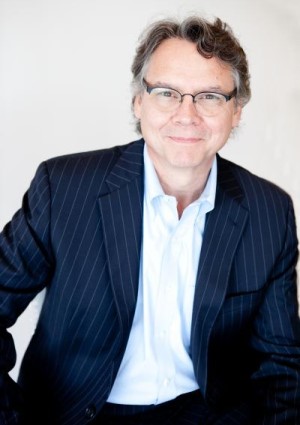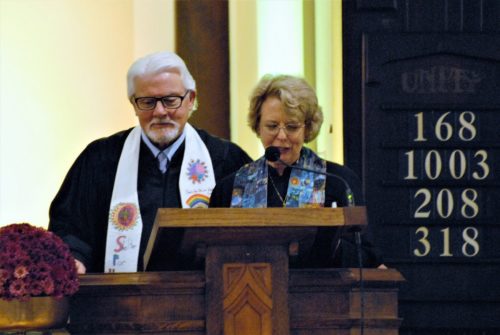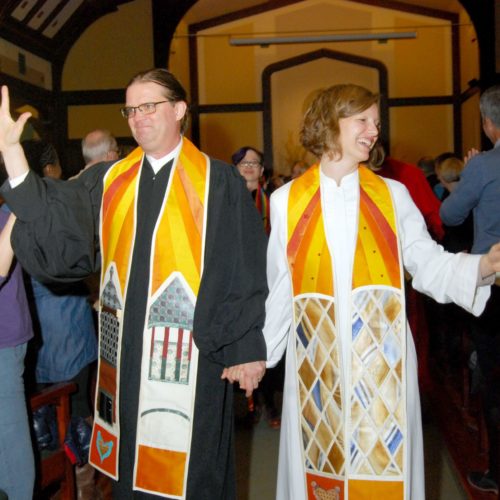History
In February 1897, twenty-eight Unitarian women in Montclair met to “consider the feasibility of forming a Unitarian Society.” Their primary motivation was to create a church school for their children and they began to prepare themselves as teachers. They incorporated in October 1897 as Unity Church of Montclair. Liberal religious education for children and youth has been a central concern of our congregation since those early days.
By 1898 when the first minister, Reverend Arthur Hastings Grant, was called, both the church and the church school were organized. Rev. Grant was succeeded in 1902 by Reverend Leslie Sprague. Reverend Sprague started the Unity Club to host lectures by “liberal speakers . . . not likely to be heard in our community” and served as VP of the local Women’s Suffrage Organization. Reverend Sprague was known as “The Builder” because he helped several churches build their buildings and then left to help build another. In 1902, the congregation purchased a plot of land on Church Street for $4,000. Within two and a half years, the current sanctuary had been designed, constructed, and paid for by the congregation ($19,050), and was dedicated in January 1905. The double chair pews in the sanctuary were purchased for $1.65 per pair, and are still in use.
The Reverend Edgar Swan Wiers was called in 1906 and continued as minister until his death in 1931. When Reverend Wiers joined the church, it had 90 members. The first organ was installed in 1909. In 1909, the church started the Unity Forum, which brought prominent speakers to Montclair including William Jennings Bryant, Clarence Darrow, W.E.B. DuBois, Robert Frost, Mother Jones, Margaret Sanger, and Booker T. Washington. In 1913, the church doubled its size by adding two transept bays, a chancel, social room, kitchen, kindergarten, and office.
In 1914, Ladies Home Journal published a profile of the church called “An Effective Suburban Church,” in which they said that the church had a congregation of 300 and the building was in use 25 days a month.
On March 2, 1919, a fire consumed the entire roof of the church building and necessitated expensive repairs. $32,000 was raised. During the repairs the congregation met at First Congregational Church. The building was rededicated in 1920, with the addition of the kitchen, Fletcher Hall, and the Alliance Room.
Unity Institute was organized in 1920, perhaps partly to help raise money for the repairs. It brought performers including Marian Anderson, Jascha Heifetz, Yehudi Menuhin, Lilly Pons, and Paul Robeson to Montclair. When the town built a new high school auditorium that seated about 1,500 people, we frequently filled it with our concerts. (By 1985, other series in New Jersey were also offering concerts and Unity Institute became a separate non-profit organization. New Jersey Performing Arts Center (NJPAC) opened in 1997 and around that time the Unity concerts ended.)
Meanwhile, the Travel Lectures brought speakers such as Amelia Earhart. Finally, starting in 1922 and running until 1988, the Collegiate Pulpit, organized by Dr. Wiers and funded primarily by profits from the Unity Institute, brought speakers of national and international stature to our pulpit four times a year. Collegiate Pulpit speakers included Langston Hughes, Reinhold Niebuhr, Bertrand Russell, and Rabbi Stephen Wise.
In March 1931, over 300 people attended a party to celebrate Dr. Wiers’ 25th anniversary at Unity Church. Then at the end of June, Dr. Wiers died suddenly at the age of 59.
Ministry of Dr. Norman Fletcher
Dr. Norman Fletcher was called after Dr. Wiers’ death in 1931. He came to Unity Church at a time of shock and mourning. The fact that he was not Dr. Wiers made Dr. Fletcher’s early years at Unity Church difficult. For many years he and his family were asked to step out and wait while the congregation had heated debates about his tenure. It took over ten years for Dr. Fletcher to be accepted as the congregation’s minister, but he was eventually respected and beloved. At this time, there were about 650 members and “persons connected with the church.”
As a founding member of the Montclair NAACP, Dr. Fletcher demonstrated his concern for civil rights and social justice for all members of our community. In a 1935 sermon entitled “Break That Line – The Color Line,” Dr. Fletcher said, “Unless Christians are personally and collectively active in breaking the color line, their doctrine of goodwill is a sham and their preachment of brotherhood a hypocritical mouthing.”
Thurgood Marshall, then an attorney for the NAACP Legal Defense and Education Fund, spoke at the church in 1957, three years after his successful arguments in the Supreme Court case Brown vs. Board of Education.
Dr. Fletcher and members of the congregation established the Memorial Society of Essex, an end-of-life planning organization that still exists, and at one point had over 1,500 members.
In 1937, the church was “built beneath.” A large basement was dug out beneath the sanctuary and divided into rooms for the Sunday school. In 1946, the church bought a parsonage at 66 Overlook Road in Montclair. (We no longer own a parsonage.)
In February 1938, a fire damaged Fletcher Hall. The congregation responded by repairing and refurbishing the space.
During the 1950s, church membership and church school registration soared. The church school grew from 87 in 1953 to 122 in 1954. Chairs were placed in sanctuary aisles to accommodate the large number of Sunday worshippers, resulting in much discussion of the need for new space. Church membership peaked in 1961 at 772, with an average Sunday attendance of 273 and Easter attendance of 455.
Around this time, the congregation voted to change its name to The Unitarian Church, Montclair, New Jersey, to avoid confusion with a separate religious group called Unity Center that had recently built its home nearby.
In 1957, the church purchased the vacant former Carnegie-built Montclair Public Library, which had been adjacent to the church, for $37,025. The 500% increase in Sunday School enrollment during a 10-year period justified the expansion. By 1960-61, RE enrollment had increased to 449 young people. Between 1959 and 1963, renovations to the former library building provided five additional classrooms on the first floor. In 1970, the church bought a second house on Graham Terrace. (As of 2016, the church does not own any real estate beyond the primary church property.)
In 1971 the church’s Modern Dance Group was founded by Phyllis Workinger and others. Its first performance was a Sunday lay-led service entitled “The Devil and Daniel Webster” with a cast of nearly 50. This group of dancers continued to perform in morning services for 20 years, with a final performance in April 1991.
After 40 years as minister of the church, Dr. Fletcher retired in 1972, becoming Minister Emeritus.
Ministry of Dr. George Pennington
 Dr. George Pennington, a clinical psychologist who had been appointed associate minister in 1970, became minister in 1972.
Dr. George Pennington, a clinical psychologist who had been appointed associate minister in 1970, became minister in 1972.
Much turmoil followed: Some congregants who liked Dr. Fletcher’s style stayed home, while others who liked Dr. Pennington’s more psychological approach attended and brought friends. In accordance with the times, the church became less formal. The late 1970s brought a significant decline in attendance at both church and Sunday school, and church revenues dipped. In fall 1981, the board held two widely attended congregational meetings on whether to retain Dr. Pennington. A very close congregational vote kept Dr. Pennington in place, but feeling it would be too difficult to lead a church that was so deeply divided, he resigned effective March 31, 1982.
After Dr. Pennington’s resignation, Dr. Josiah Bartlett served as interim minister for one year, starting in 1982. It was a quiet healing time. The congregational survey done in 1982 showed that 65% of the congregation was over the age of 50 and only 20% had been members for less than 5 years. The congregation concluded that one of the attributes of our new minister should be the ability to attract new and younger members.
Ministry of Dr. Lee Barker
 Dr. Lee Barker was called in 1983 as our sixth settled minister. As healing took place, attendance, community spirit, and church income improved. Almost immediately, Dr. Barker led us into community involvement and working together within the church.
Dr. Lee Barker was called in 1983 as our sixth settled minister. As healing took place, attendance, community spirit, and church income improved. Almost immediately, Dr. Barker led us into community involvement and working together within the church.
The church launched a project called Vision 90, a $567,000 reconstruction of our physical plant. The project took three years and was completed in 1989. We connected the “Annex” or library building to the main building, refurbished the kitchen, rebuilt the organ, and corrected drainage leaks so that we could again use the church basement for Sunday school classrooms. The Annex was transformed into a large, functional office complex and the rotunda reworked into a multi-purpose room which has since then served as an art gallery, chapel, meeting room, and reception area. The Peierls room was refurbished and a lift installed for those with limited mobility. Meanwhile, the downstairs portion of the Annex was redesigned to house the volunteer-run Thrift Shop (which no longer exists).
In 1990, Dr. Barker and members of the congregation took the lead in a community-wide effort to provide non-profit shared housing for senior citizens in Montclair. This came to fruition with Promise 95, a fundraising effort that raised $150,000 in pledges, $75,000 of which became the congregation’s contribution to the purchase and renovation of a nearby building called the Montclair Inn. The Montclair Inn is still an independent not-for-profit senior housing organization several blocks from UUCM. The remainder of the funds went to outreach projects into the community.
The church was designated a Peace Site in 1984, “dedicated to peace for all people.”
By 1985, UUCM’s auction fundraiser was an annual event. Still going strong in 2016, the auction is a festive themed evening in which attendees purchase seats at various dinners and other events, including an Italian Feast and mystery murder dinner. It brings in more than $20,000 annually and is UUCM’s largest fundraiser after the annual pledge drive. We keep some of the events at fixed prices to make them accessible, and attending the auction party is free. The dinners and gatherings are a great way for members and friends to get to know each other.
In 1986, the church set the Unity Concerts program free to become a larger community asset.
Dr. Barker worked actively to help UUCM become a Welcoming Congregation, accepting of people of all sexual orientations and identifications. Although it is part of our identity today, creating this atmosphere of acceptance was initially a major effort. People had left the church because it wasn’t accepting enough. The Reverend Scott W. Alexander from the UUA came to talk with us about it and after a committee had worked on the topic for some time, the first welcoming congregation service was in 1991. Through the 1990s, the Welcoming Committee sponsored a film series to encourage dialogue among individuals of various sexual orientations. This brought in people from across the Montclair area and may have attracted people to our congregation.
Between 1986 and 1994, the children’s RE program grew so much that the church began to offer RE classes at both Sunday services in 1991, and in 1993 hired its first full-time DRE, John Tolley. Reverend Tolley had a background of working with creative arts in a Presbyterian religious context. He was also a gay man in a committed relationship. Several RE parents had concerns about this and raised the issue with others in the congregation. However, the RE committee quickly put a stop to the discussion and John felt supported and accepted throughout his ministry. As John said in 2016, “The fact that members of the RE committee silenced the intolerance before I was even aware the issue had been raised illustrated both the importance of the work the Welcoming Congregation committee had done and the fact that indeed, the congregation had become a more inclusive, supportive community.”
Reverend Tolley studied for the Unitarian ministry during his time with us, and was ordained at UUCM in 1995. He became associate minister at The Unitarian Church in Westport in 1996.
In addition to his involvement with RE and many other programs, Dr. Barker took on a great deal of the church administration and was popular for his sermons, which often illuminated profound truths through everyday personal experiences.
Through Dr. Barker’s initiative the congregation became involved in the training and ordination of two new ministers, Linda De Santis and Jo Ellen Willis. Both helped run our RE programs.
Also during Dr. Barker’s years, we moved to two Sunday services, which he encouraged to enable further growth and to allow our many RE volunteers to attend services themselves. It was also recommended by the UUA. This was a hard decision, as many members liked being able to see everyone in the same service on Sunday. UUCM’s Undoing Racism initiative was founded in 1993 by 4 members and quickly grew to 30 active members. That year, Ron Chisom, a co-founder of the People’s Institute for Survival and Beyond (PISAB), led a 2.5-day anti-racist training workshop at the church. From this training, a core group of activists decided to become the Undoing Racism Committee of UUCM. The URC offered the PISAB training to other congregations, and to community groups in an event attended by representatives from 20 groups including the Montclair Board of Education, the NAACP, and the Salvation Army. Subsequently, URC developed a worship service called “The Dream . . . The Reality” that was offered to nearby UU churches starting in 1994. This also was received with enthusiasm. URC members were trained for and piloted an anti-racist curriculum of UUA, “Journey Towards Wholeness,” which we offered to other UU congregations in NJ.
Dr. Barker announced he was leaving in June 1994 to become the senior minister at the Neighborhood UU Church of Pasadena, California. Dr. Barker became president of Meadville Lombard Theological Seminary in 2003 and still holds that position.
From 1994 to 1995, John Papandrew served as Interim Minister. Our search documents for our next senior minister stated that our congregation had 560 people, consisting of 410 adults and 150 children.
Ministry of Reverend Charlie Ortman and Reverend Judy Tomlinson
 In 1995, Reverend Charles Blustein Ortman became our seventh settled minister. During Reverend Ortman’s long tenure, the congregation focused on our vision as a community, our desire to foster the growth of our denomination through sponsoring intern and affiliated ministers, our commitment to a stable religious education program, and support of social justice activities. Early in this period, in 1997, we celebrated our 100th Anniversary.
In 1995, Reverend Charles Blustein Ortman became our seventh settled minister. During Reverend Ortman’s long tenure, the congregation focused on our vision as a community, our desire to foster the growth of our denomination through sponsoring intern and affiliated ministers, our commitment to a stable religious education program, and support of social justice activities. Early in this period, in 1997, we celebrated our 100th Anniversary.
In 1999-2000, Rosemary Bray McNatt was here as an intern. She was UUCM’s first African American minister. Reverend McNatt is currently the president of Starr King School for the Ministry.
In 2000, Reverend Judy Tomlinson began serving our congregation as Minister of Religious Education. She had most recently been the DRE at Unitarian Universalist Community Church of Santa Monica and had completed seminary and achieved preliminary fellowship with the Ministerial Fellowship Committee of the UUA. In the search that resulted in hiring Reverend Tomlinson, we looked for someone who could stay a long time, since there had been a fair amount of turnover in this role in the preceding years. Reverend Tomlinson was ordained by UUCM in May of 2001.
In the fall of 2000, the board went on a retreat with the Reverend Paul Mueller, who introduced the idea of covenant groups. Reverends Ortman and Tomlinson recruited leaders and the groups started in February 2001. The goals were to create intimacy and spiritual depth, and to be of service to our congregation. In 2002, we hired an assistant minister, Reverend Mary Tiebout, who took over the covenant group ministry and also provided pastoral care. She was with us for 3 years.
In 2004-05, Reverend Cheryl M. Walker was an intern with our congregation. She is now minister of the UU Fellowship of Wilmington, North Carolina. In 2006-07, Wendy Pantoja interned with us. She was most recently the interim minister at North Universalist Chapel Society in Woodstock, Vermont.
The Green Sanctuary committee was formed in 2001 with the goal to be accredited by the UUA, which we achieved in 2011. The committee, now led by Silke Springorum, has helped to infuse more Earth-based theology in worship services and the RE program, developed a Green Policy for the congregation, and helped to purchasing electricity from renewable sources. A recent outreach project was the Deep Ecology Literacy Series between 2013 and 2015, which featured speakers, films, and discussions about innovative, practical, and workable solutions to the ecological challenges we face, with attendance of up to 60 people.
Reverend Ortman brought new traditions to UUCM. An accomplished musician, Reverend Ortman brought new kinds of music and movement into our worship. He encouraged and shared poetry and theatre arts. He supported the beautification of our sanctuary and the addition of the Unity Gallery to honor the visual arts. His introduction of Water, Fire, and Earth Communions to our existing Flower Communion strengthened our appreciation of the natural world and the ongoing cycles of life.
Although we did not lose any congregants on September 11, 2001, the event shook the congregation and the subsequent political environment inspired us to antiwar efforts and interfaith dialog. The congregation met for prayer that night and Reverend Ortman postponed his sabbatical to be with the congregation. Beginning on September 12, 2001, and continuing to the present, members of UUCM have engaged in dialogue with local Muslim communities. This outreach effort, called “True Justice,” was led by UUCM member Jerry Fried and Imam Dr. Mohammad Qatanani and outreach director Mehdi Eleififi at the Islamic Society of Passaic County in Paterson, NJ. Groups attended prayer services, potluck suppers, discussion groups, and gatherings of individuals from the different congregations. UUCM member Steven Mintz organized a joint UU/Islamic Society Men’s Group gathering in May 2016, at which many men were visibly moved by their common values and priorities.
Reverend Ortman had a passion for social justice. “Even as a grade-school student, I was writing essays on racial equality,” he said in an interview with a local newspaper. He went to a Catholic grade school and was inspired by a liberal priest there who “taught the kind of love that St. Francis of Assisi taught.”
Between 2006 and 2009, the Unitarian Universalist Legislative Ministry of New Jersey was founded (now UU Faith Action NJ). UULMNJ’s goal is to provide structure for non-partisan social justice activism by New Jersey UUs. The Princeton UU congregation was a leader in founding UULMNJ, and UUCM was a supportive partner from the beginning, attending formation meetings. Reverend Ortman was a board member, and in subsequent years members of our congregation have been involved, including the Reverend Craig Hirshberg (a former member of UUCM) as executive director from 2011 to 2015, Judy Strachan and Nick Lewis as Board President, and Laurice Grae-Hauck as Outreach Coordinator and Administrator.
Marriage equality for gay and lesbian people became an important issue for our congregation. Starting in 1999, we provided office space for Garden State Equality. Reverend Ortman traveled to Trenton often to testify on behalf of marriage equality and to participate in the governor’s advisory committee concerning marriage equality. He was one of a few ministers who traveled to New Paltz, New York, in 2004 to illegally marry same-sex couples. Reverend Ortman and members of the congregation demonstrated in Trenton and Washington DC multiple times during the struggle. The Congregation hung a “Standing on the Side of Love” banner for marriage equality on our building. Many members of the congregation wrote letters and made speeches on behalf of marriage equality.
According to Reverend Ortman, “When we issued our report for the Civil Union Review Commission, it was immediately shelved by the members of the Legislature and the governor, but it was cited by other states’ legislatures and in court rulings as they became marriage equality states before New Jersey did.” Thanks to the work of many, including the Unitarian Universalist Legislative Ministry of New Jersey, marriage equality became law in New Jersey in September 2013.
In the almost 25 years since the group’s founding in 1993, the Undoing Racism Committee has led numerous discussion groups, workshops, trainings, film screenings, and lectures, including Dr. Joy DeGruy Leary and Pulitzer Prize-winning author Douglas Blackmon. URC also sponsored workshops for high school students on anti-racist issues, such as challenging racial and gender stereotypes in popular culture. Annual “Dance for Justice” fundraising events were held.
In 2008-09, URC members who were not UUCM members created the Anti-Racist Alliance of North Jersey. ARA-NoJ has offered PISAB trainings almost quarterly in the past 8 years. URC is now part of this coalition, which encompasses many anti-racist organizations.
In recent years, areas of focus have included immigration reform, advocating for detainees, Black Lives Matter, Ending Mass Incarceration, and support for ending Solitary Confinement in NJ prisons.
In summer 2015, the congregation enthusiastically supported the creation and display of a Black Lives Matter banner for the sanctuary exterior. In 2015-16, Undoing Racism sponsored a 4-part series of Conversations on Black Lives Matter, open to the congregational and wider community. These presented an opportunity to deepen our understanding of and commitment to racial justice. Members of the congregation have attended prayer and activism events with the aim of ending police brutality against people of color. 2016 is URC’s third year of calling attention to the National Month of Resistance to Mass Incarceration, Police Terror, and the Criminalization of Youth. The group highlighted the issue with major events, including a rally and march on Church Street in downtown Montclair.
In June 2016, as part of our campaign to end solitary confinement and in partnership with the Unitarian Universalist Legislative Ministry of New Jersey, UUCM members built a replica of a solitary confinement cell on our lawn and invited congregants and passers-by to experience it and to press for change. The replica is now available to other organizations and houses of worship and has an active tour schedule in fall 2016.
In preparation for a capital campaign in 2003, the Congregation participated in a strategic planning workshop over one weekend. The program, called Searching for the Future, was moderated by a consultant for the UUA. Each session was for 10-15 people and the UUA consultant moderated each session. Approximately 100 people participated in the event. Member Nancy Felix organized the weekend and worked closely with the UUA consultant on the workshop.
A key finding of the weekend was that we did not feel connected as the community and we did not connect to others beyond our Sunday services. Thereafter, we created the Neighborhood Circle groups, which were cross-generational gatherings focused on neighborhoods in Montclair and surrounding towns. Some of the Neighborhood Circle groups quickly petered out due to busy schedules and lack of shared interests, but some continued for a while, and one is still active, with members in their 90s.
The Searching for the Future weekend also helped the board and an elected Planning Committee create a detailed architectural Master Plan for UUCM in 2005. The Planning Committee worked with a local architect and received input from many groups, including RE, the Buildings & Grounds Committee, the ministers and staff, and congregants involved in social events and fundraising. The goals for the Master Plan were to unify our sprawling spaces; create larger, more flexible social space; renovate the sanctuary; create more space for RE; modernize the buildings; and preserve the history and continuity of our religious home.
There were three phases to the 2005 Master Plan:
- Sanctuary restoration, restored pews, lighting, sound system, painting and refinishing, carpeting, air conditioning and heating, roof repairs. Estimated cost: $600,000.
- New “Commons” connecting the sanctuary and Annex. Estimated cost: $1,150,000.
- Transform the Annex into a new social hall with new terrace and playground. Transform Fletcher Hall into UUCM offices. (Basically, reverse the current functions of these two spaces.) Estimated cost: $1,465,000.
The congregation adopted the plan and a capital campaign for Phase I at a congregational meeting. (Thus far, we’ve only completed that first phase of the master plan.) The fundraising effort was active from 2005 through 2008. We hired an outside fundraising expert, created a vision with architectural renderings, and asked members to give over a 3-year period.
Between 2005 and 2008, the congregation raised $945,000 for a complete rehabilitation of the Craftsman-style sanctuary and Fletcher Hall. Chris Corbett and Nancy Felix were co-chairs of the fundraising effort. The renovation included new paint; refinished woodwork; air conditioning; pew renovation; light, sound, and video systems; and wheelchair access and a new ramp entrance to Fletcher Hall. Karen Nielsen-Fried and David Lewis led the aesthetic aspect of the project, which included choosing new and brighter colors for the painted sections in the sanctuary and Fletcher Hall.
The renovation was done by a firm that specializes in liturgical restoration. Many of the lead designer’s previous projects had been Catholic churches, and our building was the first UU space he had worked on, so we needed to have a theological discussion to clarify our non hierarchical structure (so, no clouds on the ceiling, only a moderate amount of gold trim, and no God’s hand reaching out!). We explained that Unitarian Universalists didn’t look upwards toward heaven, but focused spiritually on life on earth.
Before the painting began, we had a section of the sanctuary wall painted with the design and color scheme to test the congregation’s reaction. Karen, David, and the Board president stood by the wall section after services on several Sundays and fielded questions and got reactions. There were many, of course! Some members were confused by the design and by so much color. We talked with them about the design, how it had a rhythm that would repeat throughout the sanctuary and Fletcher Hall with some variations, almost like a musical composition (Bach came to mind). After several weeks of discussion, we felt that we had a consensus and that we could move forward.
The pew benches in the sanctuary received a major upgrade. A survey of the membership established that people wanted to keep them rather than to install permanent pews. We found a company that took them all apart, refinished each piece, and reassembled them to look as they did 100 years ago. The cost was $1,300 each this time! It was well worth the investment as it maintained the character of the church as we loved it.
With the addition of new carpeting, new chairs for the side areas, and better lighting, the transformation of the sanctuary was complete. From the historical vision of the room with its emphasis on the wood framing with plaster in between, it was now a room full of color, framed with wood and beautifully articulated detail. When the work was finished, the results were stunning and made the room bright, welcoming, and happy. Reactions by the members were overwhelmingly positive!
Today, one of UUCM’s most important areas of ministry is our involvement in MESH: Montclair Services for Hope, which began in 2012. MESH was founded in 2005 by the pastor of St. Luke’s Episcopal Church in Montclair. Through MESH, local churches, synagogues, and non-profits provide nutritious evening meals 6 days a week to Montclair’s needy. UUCM’s turn is Wednesday evening, when about 70 people are served a 5-course meal that includes live music performances. The meal is prepared by about 20 volunteers, mostly from UUCM.
In 2007, after years of discussion and an earlier failed vote, the Unitarian Church, Montclair, New Jersey, changed its name to the Unitarian Universalist Congregation at Montclair (UUCM).
In 2009, at age 58, Reverend Ortman and friends biked across the country in 47 days, raising $18,000 to benefit local soup kitchen Toni’s Kitchen. In that same year, the UU Legislative Ministry of New Jersey was founded, with support from New Jersey congregations including UUCM.
Reverend Tomlinson became Associate Minister in 2010 while maintaining responsibility for Religious Education. UUCM changed the RE Assistant position to RE Coordinator, and increased the hours from 20 to 25. Around this time, Reverend Tomlinson worked with Claudia Sanders to revitalize the Covenant Group program, launching new groups in 2011. We currently have 10 groups with about 80 total participants.
The hiring of Markus Hauck as music director in August 2012 has revitalized our music program. Markus is a graduate of Berklee College of Music and the Boston Conservatory and has served UU congregations in Boston, Brooklyn, and Queens. Since Markus’s arrival, our choir has doubled in size to about 20 singers. Markus created a smaller auditioned choir and supports the lay-led children’s choir, which performs 3 to 4 times a year. In 2013 we hired Stearns Matthews as assistant music director. Many talented musicians in our congregation volunteer as guest musicians and soloists.
Recent musical highlights have included a new annual interfaith choir festival that involved 7 local congregations and over 130 singers in attendance last year (its third); a cabaret fundraiser with over 100 people in attendance; annual Hymn Sings; the creation of a composer-in residence role for longtime contributor Tom Parente; and chamber music and other concerts throughout the year. Markus is involved in the musical programming for the greater faith movement and was the bandleader in at General Assembly in New Orleans and Kansas City.
Ministry of Reverend Anya and Reverend Scott Sammler-Michael
 In 2017 Rev. Anya Sammler-Michael and her partner in ministry and life, Rev. Scott Sammler-Michael, chose shared ministry with the Unitarian Universalist Congregation at Montclair. Please read more on our current Staff Page.
In 2017 Rev. Anya Sammler-Michael and her partner in ministry and life, Rev. Scott Sammler-Michael, chose shared ministry with the Unitarian Universalist Congregation at Montclair. Please read more on our current Staff Page.

